Cotton Waste Product Description
Cotton waste refers to the by-products generated during the processing of cotton fibers. This includes remnants from cotton ginning, spinning, weaving, and finishing processes. Cotton waste is typically composed of short fibers, broken threads, and other residual materials that are not suitable for traditional textile production. Despite being considered waste, these materials can be repurposed and utilized in various applications, making them valuable in sustainable practices.
Uses of Cotton Waste
Cotton waste has a wide range of applications across different industries, including:
- Textile Industry: Recycled cotton waste can be blended with virgin cotton or synthetic fibers to create new fabrics, reducing the need for raw materials.
- Insulation Material: Cotton waste can be processed into insulation for buildings, providing thermal and acoustic benefits.
- Filling Material: It is often used as stuffing for pillows, cushions, and toys due to its softness and comfort.
- Paper Production: Cotton waste can be pulped and used to manufacture high-quality paper products.
- Composting: As a natural fiber, cotton waste can be composted and used to enrich soil in agricultural practices.
- Non-Woven Fabrics: It can be transformed into non-woven materials for use in hygiene products, medical supplies, and industrial applications.
Technical Data
Here is a table summarizing the technical data of cotton waste products:
| Property | Description |
|---|---|
| Material Composition | 100% Cotton (varies by source) |
| Fiber Length | Short fibers (typically 1-2 inches) |
| Moisture Content | 8-12% (depends on storage conditions) |
| Density | 0.5 – 0.7 g/cm³ |
| Color | Natural white to light brown |
| pH Level | 6.0 – 7.5 (neutral) |
| Thermal Conductivity | Low (good insulation properties) |
| Biodegradability | Fully biodegradable |
| Applications | Textiles, insulation, filling, paper, composting, non-woven fabrics |
Conclusion
Cotton waste products play a crucial role in promoting sustainability within the textile and manufacturing industries. By repurposing these materials, businesses can reduce waste, lower production costs, and contribute to a circular economy. The versatility of cotton waste makes it an essential resource for various applications, highlighting the importance of innovative approaches to waste management.

